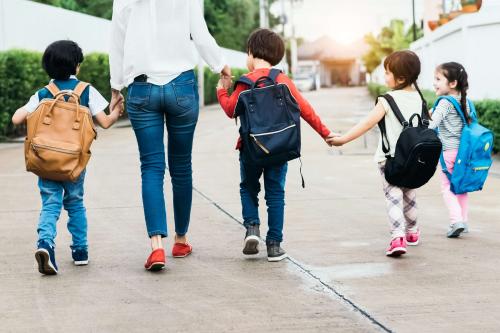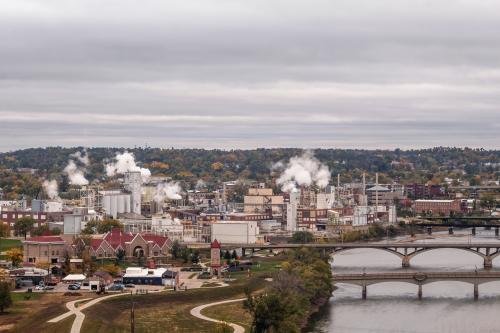In January 2023, the Community Schools Forward Task Force introduced a national consensus framework along with supporting resources to develop a common understanding of community schools and articulate essential implementation practices. The framework reflects the evolution of community school development, in particular highlighting the shift from a predominantly “wrap-around” services model to a whole-school, whole-community approach to teaching and learning that reflects the science of learning and development and explicitly includes rigorous, engaging, community-connected classroom instruction.
What is community-connected classroom instruction and what does it look like in a community school?
Community schools are a place-based strategy; the school acts as a hub for students, educators, families, community-based partners, local leaders, and other key stakeholders. These schools provide an ideal environment for “community-connected learning.” Activities are designed so students can practice skills in their real-world contexts; build upon those skills; and see their communities, identities, cultures, language, interests, and experiences as valued assets to their learning.
Community-connected learning cultivates more porous boundaries between classroom and community, and often explores social identity, equity, language, and culture. It can be learner-centered—the student identifies the direction of the work—or teacher-centered—the curriculum and partnerships are initiated by the teacher. Perhaps most importantly, community-connected teaching and learning is rigorous and relevant to the lives of students.
Best practices for community-connected learning include:
1. Inquiry-based pedagogy that prioritizes youth voices
Students develop questions and answer them through critical examination and reflection. For example, the Netter Center’s Moelis Access initiative brings together University of Pennsylvania students with students in Philadelphia’s K-12 schools for community-based, science lessons with an emphasis on problem-solving.
2. Experiential learning that promotes collaborative skills
Learning is experience-based, applied, and enables opportunities for students to work together and/or with external partners. During the RadioActive internship with a local radio station in Seattle, high school students are trained in radio production while simultaneously helping the station to center youth voices. And at Minneapolis’s South High, students learn about education by working with neighboring third graders while the district builds a pipeline for future teachers.
3. Partnerships with local organizations
Lessons are co-created by either the teacher and the organization and/or the students and the organization. In East Los Angeles, Farmdale Elementary students develop a garden in partnership with a local café and explore environmental activism.
4. Learning outside of the school campus and within the community
The city or town becomes the classroom and learning occurs in a local park, business, or museum. In rural Berea, Kentucky, community schools partner with the local library to develop a “storybook trail” that celebrates new books and cultivates community.
5. Affirming and sustaining students’ and families’ knowledge and expertise
Students share the wealth of knowledge and experience gained from their families’ lives and work with teachers to build lesson plans based on this content. For instance, students and families in Aurora, Colorado, share stories of immigrating to the United States, which are exhibited at the local history museum. And in Cuba, New Mexico, community school students are hired by the University of New Mexico and the University of Colorado Boulder to share and research local culture and language.
6. Equity-focused content and topics
Learners are encouraged to consider their role and responsibility within their community. At the UCLA Mann School in Los Angeles, the student steering committee uses youth participatory action research strategies to collect data on students’ classroom experiences to improve their school. And across the country at Fannie Lou Hamer Freedom High School in New York City’s South Bronx community, students explore the mathematics of gerrymandering in their borough.
What is needed to strengthen community-connected teaching and learning?
Community-connected learning starts with building trust in the classroom, where teachers learn about their students and cultivate connections with and between their students. Teachers understand their students’ assets and gifts, develop a deeper understanding of community inequities, and cultivate the skills to deconstruct these inequities with their students.
In the same way collaboration and leadership are essential ingredients for community-connected learning, so are dedicated time and resources for professional learning. Schools must develop professional learning opportunities that teach educators youth participatory action research, restorative practices, and critical consciousness, couched in an understanding of the community school strategy and a whole-child approach to education. Once properly trained, teachers require agency, sufficient planning time, and instructional coaching to design and facilitate these learning experiences.
Like all facets of a community school, community-connected learning can’t happen without intentional systems and a supportive infrastructure—such as reliable funding and staffing—to meet desired outcomes. For example, community schools are staffed by a coordinator—hired by the district or a lead community partner—who is tasked with “managing partnerships.” Historically, this has meant bringing in resources like eyeglasses, tutoring, extended day programming, mental health services, or access to other services so students are ready to learn. However, working with school leadership, teachers, expanded learning providers, and families, the coordinator can also play an integral role in making connections that support community-connected learning by fostering learning partnerships with local universities, arts organizations, museums, businesses, and more.
Why is community-connected learning important to community schools?
Community-connected learning must be central to how and why we educate. It is more than a different approach to teaching; it is the most effective way to teach. The science of learning and development tells us that learning happens best when students are engaged in meaningful and relevant work. As one of the key practices of a thriving community school, community-connected learning creates a crucial intersection between students’ lives and experience, real-world opportunities, and academic rigor.








Commentary
Community-connected learning in community schools: Why it is essential for whole-school transformation
August 8, 2023